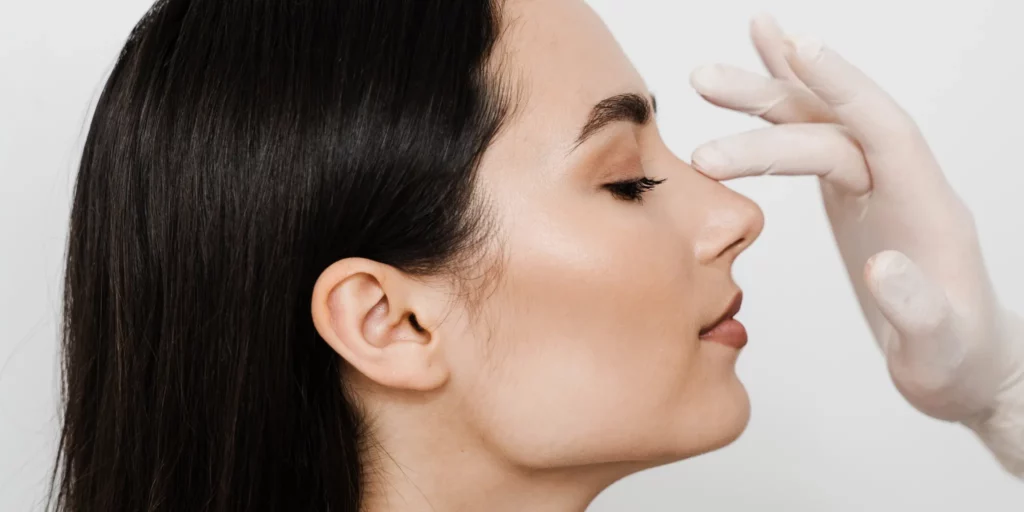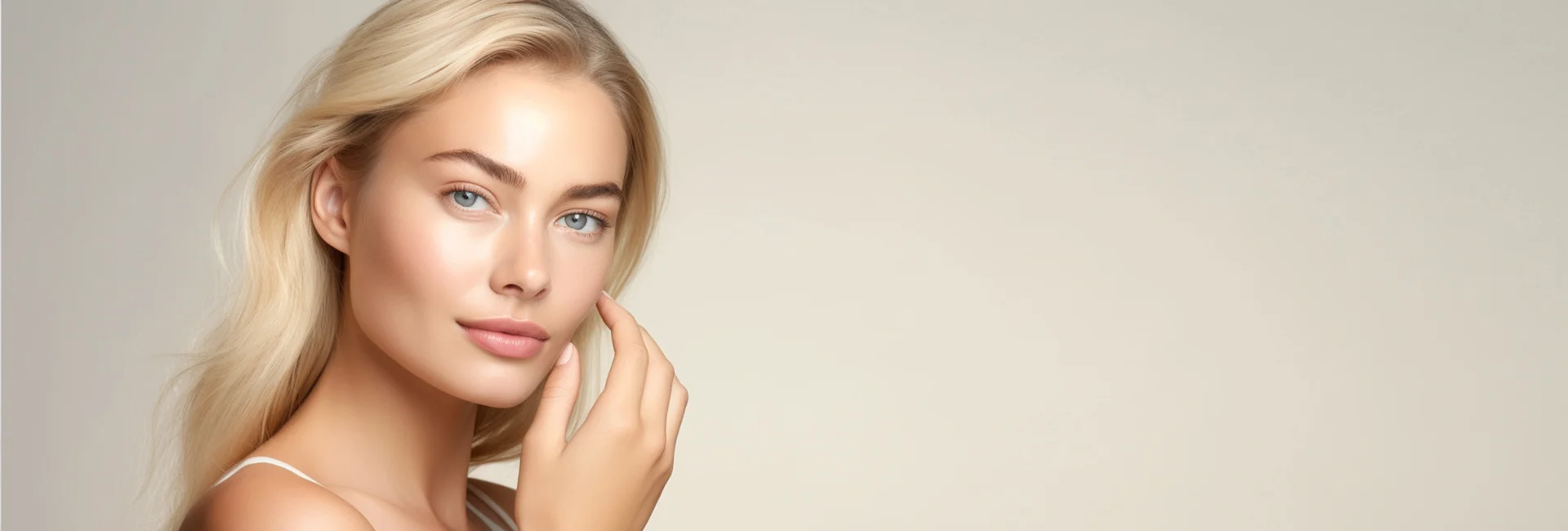Droopy Nasal Tip Correction
What Is A Drooping Nasal Tip?

Causes of Nasal Tip Drooping
A drooping nasal tip can be caused by various factors, including:
- Elongated upper or lower lateral cartilages
- Age-related ptosis due to diminished tip support, gravity, or nasal skin that has thinned over time
- Previous rhinoplasty that weakens nasal tip support
- Elongated nasal bridge or nasal septum
- Excess nasal cartilage
- Unstable attachments between upper lateral cartilages and the septum
- Trauma to the nose
Regardless of the underlying cause of a drooping nasal tip, the best way to determine if nasal tip correction is right for you is to schedule a consultation with Dr. Cangello. Additionally, if you are experiencing breathing difficulties due to a drooping nasal tip, it’s worth considering this type of rhinoplasty to alleviate your functional concerns while creating beautiful new nasal contours.

Understanding Aesthetic Goals for Droopy Nasal Tip Correction
Every patient is unique, and when it comes to droopy nasal tip correction, Dr. Cangello tailors each treatment plan to the individual’s anatomy and cosmetic goals. However, there are key aesthetic principles that guide the process. The primary objective is to create a harmonious profile with a natural-looking nasal tip. The precise location and degree of droopiness influence his surgical approach to patients seeking correction for a drooping nasal tip.
How Dr. Cangello Measures Nasal Tip Rotation
During the initial consultation, Dr. Cangello will take measurements of the nose. To determine the best approach for droopy nasal tip correction. Dr. Cangello will evaluate various factors, including the width of the dorsum and the nature and extent of the ptosis, or droop of the nasal tip. These measurements will also include the nasolabial angle, or the angle that is formed between the bottom of the nose and upper lip.
Ideal nasolabial angles for men and women can range. The optimal range for men typically lies between 90-100 degrees. For women, a more rotated tip is often preferred with a range of 95-108 degrees. Dr. Cangello looks carefully at the size, shape and orientation of the lower lateral cartilages which make up the tip of the nose. He will then diagnose nasal tip ptosis, determine the optimal nasolabial angle, and then design a surgical plan for drooping nasal tip correction to ensure the new nose meets more ideal standards. This pre-operative planning ensures that the post-operation angle measurement exemplifies a successful nasal tip rotation.

Preparing For Droopy Nasal Tip Correction
When preparing for rhinoplasty to correct a drooping nasal tip in NYC with Dr. Cangello, it’s essential to start with a consultation to discuss your specific concerns and aesthetic goals. During this initial meeting, Dr. Cangello will conduct a thorough evaluation of your nose and facial structure, helping you understand the potential outcomes and surgical plan. It’s vital to provide a comprehensive medical history and inform Dr. Cangello about any medications, allergies, or previous surgeries. Leading up to the procedure, you’ll receive detailed pre-operative instructions, including guidelines for discontinuing certain medications, avoiding smoking, and arranging for a responsible adult to accompany you on the day of surgery. Dr. Cangello and his team are committed to ensuring that you feel fully informed and prepared every step of the way, ensuring a safe and successful rhinoplasty experience.
The Nasal Tip Rotation Procedure
Surgical Techniques for Correcting Nasal Tip Ptosis
-
- Excising excessive or cartilage from the nasal tip
- Shortening the nasal septum
- Reducing the length of lateral cartilages on the outside of the nostrils to raise the “tripod” created by the medial crura and the bilateral crura3
- Suturing a cartilaginous strut graft to the medial crura to perform tip lift
- Increasing the integrity of the nasal tip by using columellar strut or septal extension graft. The latter is used when more projection is needed than can be obtained with a strut graft. This is more often necessary in those with weak and/or small lower lateral cartilages.
Recovery After Droopy Nasal Tip Correction
After undergoing rhinoplasty to correct a drooping nasal tip with Dr. Cangello in NYC, patients can expect a carefully managed and monitored recovery process. While individual experiences may vary, you should anticipate some initial swelling and bruising around the nose and possibly the eyes, which typically subside over the following weeks. Dr. Cangello will provide specific post-operative care instructions, including guidance on managing discomfort and any prescribed pain medications. Patients are encouraged to rest and avoid strenuous activities during the initial recovery period, allowing their bodies to heal and adapt to the newly refined nasal structure. It’s important to attend follow-up appointments as scheduled, as Dr. Cangello will monitor your progress and provide guidance on when it’s safe to resume regular activities. With Dr. Cangello’s expertise and support, patients can look forward to a smoother recovery process and the achievement of their desired results.
Schedule A Consultation For Nasal Tip Rotation
If you’re ready to transform your nasal appearance with precision and artistry, schedule a private consultation with Dr. Cangello in Manhattan today. Contact us to explore the possibilities of nasal tip rotation surgery and discover how you can achieve a more refined and less droopy nasal tip while preserving your natural beauty. Your journey to confidence and aesthetic enhancement begins here.
FAQs About Drooping Nasal Tip Correction
You may be a candidate if you have a drooping nasal tip that bothers you either aesthetically or functionally. Your consultation with Dr. Cangello at his New York City practice will provide you with a personalized assessment that will review and provide recommendations for your specific goals.
Open rhinoplasty involves making an external incision across the columella (the strip of skin between the nostrils) to access and reshape the nasal structures. Closed rhinoplasty is performed entirely within the nostrils. The choice between the two methods depends on your specific needs and Dr. Cangello’s recommendation.
Recovery time varies but generally involves swelling and bruising, which typically subside within a few weeks. Dr. Cangello will advise patients of case-specific post-operative care instructions to optimize healing.
In most cases, rhinoplasty for cosmetic purposes is not covered by insurance. However, if the procedure is performed to address breathing difficulties or functional issues, some insurance plans may provide coverage. It’s essential to check with your insurance provider for specific details.
While initial improvements may be noticeable within a few weeks, it can take several months to one year to see the final, fully refined results as swelling subsides and the nose settles into its new shape.
Yes, rhinoplasty can often be combined with other facial procedures, such as chin augmentation or an eyelid lift, to achieve a more balanced and harmonious facial appearance. You can discuss your options for complementary procedures with Dr. Cangello during the consultation.
